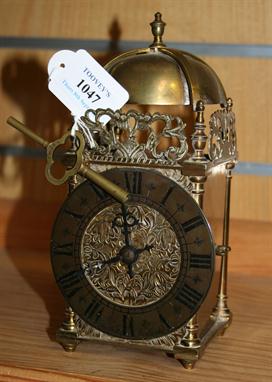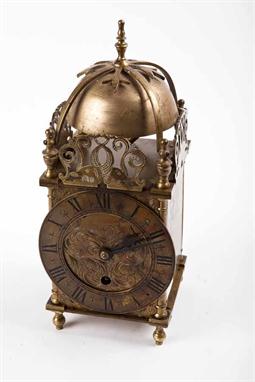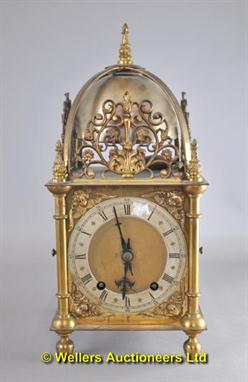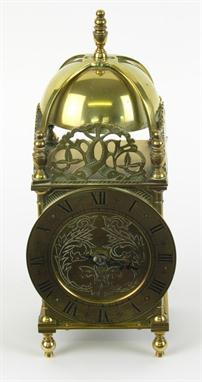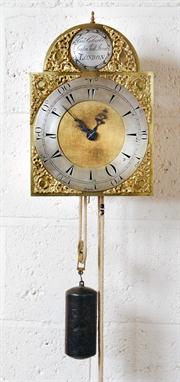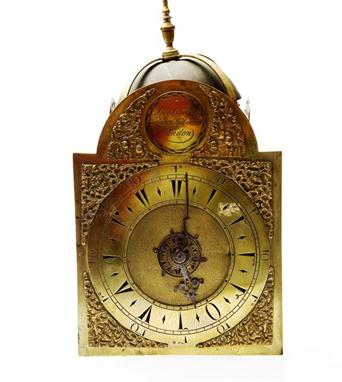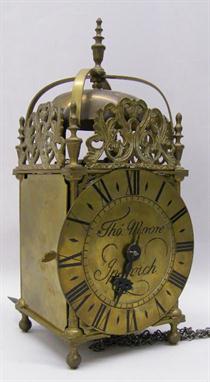We found 4372 price guide item(s) matching your search
There are 4372 lots that match your search criteria. Subscribe now to get instant access to the full price guide service.
Click here to subscribe- List
- Grid
-
4372 item(s)/page
A late 19th Century brass lantern clock with twin fusee movement striking on the bell, the chapter ring with Roman numerals framing a foliate scroll engraved centre, the case of typical form with bell surmount above foliate and dolphin pierced fret panels, turned finials and columns, on turned feet, height approx 28.5cm, with a pendulum.
A rare ebonised oak and pine `longcase` lantern clock case, Late 17th century. The hood with ogee moulded cornice above moulded rectangular door with external iron strap hinges, brass drop handle and moulded 9 by 7 inch aperture, the sides with simple rectangular doors with conforming hinges and handles, the trunk with ogee throat moulding above slender dual moulded panel inset door with three further external iron strap hinges (one replaced) and another brass drop handle, the structure continuing to from the base with brace applied below the trunk door and on later skirt, 193cm (76ins) high. Original `longcase` cases for lantern clocks are very rare, mainly due to the fact that lantern clocks were predominantly designed to hang from the wall. The construction of the current lot (often termed `pencil case`) with its slender trunk continuing to the floor reflects 17th century practice as early 18th century examples tended to resemble contemporary longcase clock cases more closely by incorporating a more developed hood and a wider section to form a plinth at the base. The mixed use of pine and oak in the current lot confirms that it was designed to take a painted finish (in this case ebonised). The simple hood side doors and external iron strap hinges are again perhaps 17th century features. Two related cases which are dated between 1660 and 1680 are illustrated in Loomes, Brian LANTERN CLOCKS & Their Makers pages 370-1.
A fine Charles II lantern clock, Richard Ames, London, circa 1680. The posted countwheel bell-striking movement with verge escapement and pendulum swinging within the frame of the clock between the trains and additional passing half-hour strike mounted behind the dial, the dial engraved with signature Richard Ames Neere St. Andrews Church in Holburn fecit in a curve towards the upper margin of the dial centre and with foliate tulip decoration to lower margin, with original iron hand and applied narrow Roman numeral chapter ring with wheatear half hour markers, the standard London third period `Lothbury` frame with column turned posts beneath dolphin engraved and pierced frets, vase turned finials and domed bell bearer, the side doors cut with slots to allow for the swing of the arrow shaped centre pendulum, the rear with iron hanging loop, on ball feet, (alarm removed), 38cm (15ins) high. Richard Ames is recorded in Loomes, Brian The Early CLOCKMAKERS of Great Britain as being born circa 1634, he was apprenticed to Peter Closon in 1648/9 and gaining his Freedom of the Clockmakers` Company in 1656/7. He was made Assistant in 1669, Warden 1676-81 and was elected master in September 1682 only to die the following month. His widow Katherine perhaps assisted by their son, William, continued the business until at least 1692. He had many apprentices, the most significant of which perhaps being John Ebsworth (Freed Apr. 1665) who became a fine maker of lantern clocks in his own right. The work of Richard Ames is discussed in Loomes, Brian LANTERN CLOCKS & Their Makers pages 127-134 where two very similar clocks to the current lot are comprehensively described and illustrated (figs. 9.5-11). All of these three examples share the same unusual features (passing half-hour strike and separately wound trains), and can be compared to another illustrated in Darken, Jeff and Hooper, John English 30 Hour Clocks pages 47-50 which only differs in not having passing half-hour strike.
A Queen Anne brass lantern clock, Thomas Reeve, Harlstone, early 18th century. The posted countwheel bell-striking movement with anchor escapement and dial signed Tho. Reeve, Harlstone to the symmetrical foliate scroll engraved centre within an applied silvered Roman numeral chapter ring with stylised fleur-de-lys half hour markers and original steel hand, with foliate pierced frets and vase turned finials beneath domed bell bearer above, with brass side doors, rear hanging hoop and spurs to the turned ball feet, 40cm (16.75ins) high. Thomas Reeve appears to be unrecorded, however another clock by him stylistically dated to around 1690 is illustrated in Loomes, Brian LANTERN CLOCKS & Their Makers page 248 where he is noted as being a goldsmith. The style of the engraving to the dial centre can be closely compared to an example by Thomas Moore of Ipswich illustrated by Loomes on page 244, suggesting that the current lot can be stylistically dated to around 1710.
A Queen Anne `wing` lantern clock, John Crucefix, London, early 18th century. The posted countwheel bell-striking movement now with pin-wheel escapement with adjustable pallets, the dial engraved with signature John Crucefix, London within a band of foliate scrolls with iron hand and applied Roman numeral chapter ring with star half hour markers, the frame with column turned posts beneath foliate engraved and pierced frets, vase turned finials and domed bell bearer, the side doors fitted with shaped pendulum projections capped with further foliate pierced and engraved frets, the rear with iron hanging loop above iron backplate fitted with spurs, on ball feet, (lacking pendulum and weight), 35.5cm (14ins) high. John Crucefix is recorded in Baillie, G.H., Ilbert, C.A. and Clutton, Cecil BRITTEN`S OLD CLOCKS AND WATCHES AND THEIR MAKERS as being Free of the Clockmakers` Company in 1712. A similar example was sold in our Bristol, Apsley Road saleroom 2nd November 2004 lot 657.
A rare William III brass and iron lantern clock, Unsigned but probably by Richard Breckell, Holmes, Lancashire, late 17th century. The posted countwheel bell-striking movement with anchor escapement and iron movement plates, the dial engraved with a central five-petal rose within a loosely symmetrical tulip ground, with iron hand and applied narrow Roman numeral chapter ring with stylised sword hilt half hour markers, the frame with square section iron pillars incorporating square caps and bases beneath foliate engraved and pierced frets, vase turned finials and domed bell bearer, the rear with iron hanging loop above iron backplate fitted with spurs, on ball feet (dial with cracks and losses to corners), 34cm (13.5ins) high. This highly individual and interesting lantern clock can be directly compared to and example inscribed Richard Breckell, Holmes Fecit illustrated and described in Loomes Brian ENGLISH LANTERN CLOCKS & Their Makers pages 309-11. Both examples share use of square section iron pillars and movement plates as well as a thin brass dial plate and traditionally fitted bell-bearer. The current lot also demonstrates a few further idiosyncracies, for example the use of separate winding clicks for the trains (rather than Huygens endless rope winding), resulting in the bell hammer being placed on the right hand side of the movement. Other features such as the finial castings which appear to be unique, and the backcock which is similar to those found on clocks by John Sanderson of Wigton are also noteworthy.
A William III brass lantern clock with ten inch square brass dial, Daniel Quare, London, circa 1695. The posted countwheel bell-striking movement with column turned corner uprights and now with anchor escapement, the 10 inch square brass dial with matted centre within an applied silvered Roman numeral chapter ring with stylised sword hilt half hour markers and signed Dan Quare, London to lower edge, with original steel hand and angles applied with winged cherub head and scroll cast spandrels, the frame with foliate pierced side frets and vase turned finials beneath domed bell bearer above, with rear hanging hoop and spurs to the turned ball feet, (lacking one side door and alarm) 40cm (16.75ins) high. Daniel Quare was admitted as Brother of the Clockmakers` Company in April 1671 and by 1683 he was working from Exchange Alley, London. He was selected as a member of the Court of Asssistants in 1698, later becoming Master in 1708. The following year he took a former apprentice, Stephen Horseman, into partnership which presumably lasted until Quare`s death in 1724. He was a fine inventive and commercially-minded maker who supplied clocks to significant European Royal and Aristocratic clients as well the Court of William III. As a Quaker, Quare refused an invitation from George I to be appointed `Royal Clockmaker` as his beliefs would not allow him to undertake the Oath of Allegiance, however an informal arrangement was agreed where Quare had open access to the palace via the back stairs. In addition to clocks, Quare is also famous for his `portable weather glass` or pillar barometer for which he sought a patent via the Clockmakers` Company in 1695. After his death in 1724 he was buried at the Quaker`s burial ground at Bunhill Fields.
An important Charles II walnut table clock, John Wise, London 1675-80. The substantial seven double-baluster turned latched pillar twin fusee movement with bolt-and-shutter maintaining power and striking on a bell mounted above the 9 x 6 inch movement plates via an outside countwheel and vertically pivoted hammer with fine scroll engraved `S` shaped top pivot potance, the large spring barrels with substantial blued steel turned set-up wheels and clicks mounted on the backplate with engraved John Wise, Londini fecit signature between, the 9 inch square gilt brass latched dial with calendar aperture and shutters engraved with male and female profile portraits to the finely matted centre within applied silvered Roman numeral chapter ring with stylised fleur-de-lys half hour markers and Arabic five minutes within the outer minute track, with scroll pierced blued steel hands and the angles applied with gilt winged cherub head cast spandrels with bolt-and-shutter lever slot between the lower two, the case of Knibb `phase I` design with foliate cast gilt hinged handle to the shallow dome above foliate scroll pierced fret to the upper rail of the front door, the sides with rectangular glazed apertures, on moulded base with later brass squab feet, (now with anchor escapement and later movement securing brackets), 37cm (14.5ins) high. Provenance: the property of a Gentleman, Oxfordshire. The current lot is a `family` piece which to the vendor`s knowledge has been in been in the family collection for as long as anyone can recall (at least three generations). John Wise senior is recorded in Loomes, Brian The Early CLOCKMAKERS of Great Britain as born circa 1625 and apprenticed to Peter Closon through T. Dawson in 1638, gaining his Freedom in October 1646. He apparently lived in Warwick 1653-68 where he repaired the clocks at St. Nicholas and St. Mary`s churches, the latter providing the venue for the baptism of three of his children. He moved back to London in 1669 where he was re-admitted to the Clockmakers` Company by redemption. He took many apprentices including no less than six of his sons; Richard (Free 1679), John (Free 1683), Thomas (Free 1686), Joseph (Free 1687), Peter (Free 1693) and Luke (Free 1694). He is thought to have been working from `neere the popeshead in Moorfields` in the year of his death in 1693. Although several early longcase and lantern clocks by John Wise senior are known, table clocks however appear to be extremely rare. Perhaps the best known example is an unusual single-handed timepiece is illustrated in Darken, Jeff HOROLOGICAL MASTERWORKS pages 82-3. Despite obvious differences, this timepiece does share some similarities with the current lot, for example the wheel-work has the same finned-collet design and the stopwork has the same pronounced disc cam to the fusee. The case also utilises the same highly individual casting for the carrying handle albeit in a more complete form. The movement of the current lot is of notably substantial construction, which although in itself is not particularly unusual for the period is noteworthy. The detail design and layout of the movement is perhaps more interesting in the way that it does not immediately conform with the prevalent Fromanteel/Tompion/Knibb and East/Jones schools of clockmaking. The backplate layout with its external clicks, positioning of the countwheel, and the way in which the movement is signed is perhaps more similar to a movement by Matthew Crockford (with altered dial and associated architectural case) which was sold at Sotheby`s London Important Clocks.. 13/10/1988, lot 211. The Crockford movement also shares the same number of movement pillars, has maintaining power, calendar aperture and is of similar dimensions. The double baluster movement pillars used on the current lot are similar in weight and detail to the single baluster design used by Edward East (see Dawson, Percy G., Drover, C.B. & Parkes, D.W. Early English Clocks page 86, plate 106) but differ by being doubled to compensate for the greater relative distance between the plates. The vertically pivoted hammer used on the current lot is an unusual, perhaps archaic detail. The case very closely resembles those used by Joseph Knibb for his `phase I` clocks and can be directly compared to an example illustrated in Dawson, Percy G., Drover, C.B. & Parkes, D.W. Early English Clocks page 418, plate 596.
An 18th Century and later Continental 30 Hour Lantern Clock, the “Hoop and Spike” case with strapwork frame suspending the bell, over pierced panels and cast finials, to a Roman and Arabic dial with steel hour hand (minute lacking), and signed G Bezard – A – Oriien, to a movement with four cast pillars and verge escape with back mounted count wheel and strike on a bell, height 14 ½”
An early 20th Century Lacquered Brass Mantel Clock, modelled in the form of a lantern clock, with strapwork supported bell over pierced and engraved panels, to an oversize Roman chapter ring with inside quarters, track and matted centre, on cast feet, to black painted hands, to a French movement with platform escapement and strike on the bell, height 12”
A late 20th century silver replica lantern clock with bell in an arched frame above pierced and arched foliate and dolphin mounts, the chapter ring with Roman numerals and the dial with engraved flowers. The hallmarked case, stamped with the retailer`s name" Charles Frodsham & Co. London" and also "W.H.King" (24cms high)
SYMONDS, R.W. `Thomas Tompion His Life and Work`, Spring Books, 1969. fo. in d.w, Tog.with `The First Twelve Years of The English Pendulum Clock or The Fromanteel Family and Their Contempories 1658-1670`, A Loan Exhibition at The Exhibition Galleries of Ronald A. Lee`, London, 1909. Plus WHITE, George, `English Lantern Clocks`, Antique Collection Club, 1989, in d/w. Plus similar interest.
A late 17th/early 18th Century brass lantern clock by Humphrey Marsh of Highworth, Fecit No. 110, the 6.5ins silvered chapter ring with Roman numerals and single hand, the dial centre engraved with leaves and flowers to the brass and iron framed movement with verge escapement and short bob pendulum, contained in case framed with four brass pillars with turned finials and pierced and engraved dolphin pattern frets, on turned feet, 14.25ins high Note: Marsh of Highworth (Wiltshire) recorded as died 1733, business carried on by his widow, Jane.
A part-late 18th/early 19th century oak, boxwood inlaid and crossbanded longcase clock, having moulded cornice above a square glass enclosing a bell striking lantern clock-type movement, faced by brass dial named William Grimes, London. The trunk with narrow three quarter length door above a box base on bracket plinth.
A William III brass lantern clock, 17th century. With an engraved brass dial and chapter ring, with three foliate pierced `frets` to the top, cut steel hand, AMENDMENT: the movement is a weight driven anchor escapement striking on a bell. it is not (with verge escapement with central swinging pendulum, count wheel striking on bell,) height 39 cm, (no pendulum).
AN ENGLISH BRASS LANTERN CLOCK, LONDON, FIRST PERIOD unsigned, the dial finely engraved with a ring of flowers, the silvered chapter ring of roman numerals with quarter and star shaped half divisions, having iron hand, strapwork frets, banded ovoid finials, bell straps divided by leaves and iron bell, the movement with cruciform bars and now with anchor escapement, on bulbous feet, 41cm h, c1625-30 In 1987 this clock was the subject of correspondence (with which it is sold) between the late owner and George White, the author of English Lantern Clocks, published in 1989. Sir George, to whom the enquiry had been referred by the British Museum, observed that the rough castings of the frame can be found on a number of clocks by William Bowyer of Leadenhall Street. He also commented on the engraving which he describes as "particularly beautiful" and "full of [symbolism]" although suspecting that the engraver had executed it the wrong way up! ++Alarm work, doors, back, hoop, spurs and some other parts missing; long in the late owner`s possession and not subject to any recent or `professional restoration`, requires a light clean, but essentially complete and a good example from this early period. Consigned by executors
Good large Eureka brass lantern electric clock, the 7" brass chapter ring with foliate engraved inner ring stamped Pat. no. 14614-1906, enclosing a skeletonised glazed centre, also stamped no. 2229 at six o`clock on the chapter ring, surmounted by pierced dolphin frets, strapwork, bell and baluster finial, 17" high
A rare Italian brass grande sonnerie striking lantern/chamber clock Unsigned, early 18th century The substantial posted frame with finely turned `Doric` column posts, vase finials and compressed bun feet, enclosing three train movement with verge pendulum escapement mounted on the top plate, central train striking the quarters on two bells via a countwheel mounted between the front two movement plates, and third train striking the Italian six-hour notation every quarter on a third bell (hammers and linkages incomplete), the 12 inch brass break-arch dial with applied six-hour Roman numeral chapter ring with stylised sword-hilt half hour markers and outer minute track and replaced winged cherub head spandrels to angles, the arch with domed boss engraved Gloria Mundi Sta transit flanked by dolphin cast mounts, (lacking pendulum and weights), 42cm high overall. DESCRIPTION TO BE READ IN CONJUNCTION WITH ‘IMPORTANT NOTES REGARDING THE CATALOGUING OF CLOCKS’ printed in the sale catalogue or available from the auctioneers on request. The movement of the current lot demonstrates a high degree of skill in both the working out of the complex system of striking (and how to lay out the trains in an efficient manner) and in the high level of finish (from the crisp architecturally accurate turning of the frame down to the finely detailed fettling of the steelwork). The six hour dial and related striking mechanism were a throw-back to the monastic roots of Italian timekeeping, where the day was divided according to prayer times and started at midday. By the mid 18th century most of Italy had adopted the twelve hour system used throughout the rest of Europe. The inscription Gloria Mundi Sta transit engraved to the boss in the arch of the dial translates as `Thus passes the glory of the world`. This phrase was traditionally spoken as part of the Papal coronation ceremony, with the newly installed Pope being stopped three times during his procession and confronted with this phrase as a reminder of the passage of time.
A brass lantern clock 17th century and later The posted countwheel bell-striking movement now with dial engraved with a winged female mask and foliate scrolls issuing from an orb around a rosette to centre within applied Roman numeral chapter ring with arrow-head half hour markers and calendar aperture at 6 o`clock, the lower angles bearing signature Bilbie ChewsSoke, with first period pattern foliate pierced frets and bell housed in a domed bearer above, with iron backplate and on ball feet, (side doors lacking, composite), 37cm (14.75ins) high. DESCRIPTION TO BE READ IN CONJUNCTION WITH ‘IMPORTANT NOTES REGARDING THE CATALOGUING OF CLOCKS’ printed in the sale catalogue or available from the auctioneers on request. Provenance: The family of the late Ernest Hucker, The current lot is illustrated in Moore, Rice, and Hucker BILBIE and THE CHEW VALLEY CLOCK MAKERS page 179. The dial of the current lot can be directly compared with an example described as a type often found `on modern forged lantern clocks` illustrated in White, George English Lantern Clocks page 452.
A fine Charles II brass lantern clock John London, Bristol, circa 1675 The posted countwheel bell-striking movement with early conversion to anchor escapement, the dial centre with characteristic tulip engraving and signed John London in Bristoll in flowing script to upper margin, within an applied narrow Roman numeral chapter ring with stylised wheat sheaf half hour markers and engraved radial designs to angles, the frame with one-piece finial, post and feet castings, ‘lion and unicorn’ armorial frets and bell contained within the domed bearer above, (lacking pendulum and weight), 42cm (16.5ins) high. DESCRIPTION TO BE READ IN CONJUNCTION WITH ‘IMPORTANT NOTES REGARDING THE CATALOGUING OF CLOCKS’ printed in the sale catalogue or available from the auctioneers on request. Provenance: The property of a private collector. Illustrated and discussed in Loomes, Brian Lantern Clocks pages 178-81 John London is first recorded gaining his freedom of the City of Bristol as a gunsmith on 2nd June 1675, on August 10th 1678 he married Mary Baker otherwise relatively little is known about his life. He is perhaps best known for being the first Bristol based maker of longcase clocks of which a handful of eight-day movements and one complete thirty-hour example survive. His work is highly distinctive with generous use of brass and exuberant engraving. When his sole surviving complete thirty-hour clock (exhibited TIME & PLACE English Country Clocks 1600-1840 The Antiquarian Horological Society at The Museum of the History of Science, University of Oxford, 25th November 2006- 15th April 2007 exhibit number 6) is compared with the current lot, striking similarities become apparent. Firstly the same frame castings are employed with the only differences being the finials which are turned down to buttons on the longcase and the feet which retain small extensions in the castings. Secondly the movements closely compare exhibiting the same details such as heavily tapered arbors, fly castings and unusual keyhole shaped decorative cut-outs to the bases of the movement plates. Finally the dial engraving, which are clearly by the same hand and possibly executed by London himself. Both dial centres are decorated in the same manner with large scale foliage and flower heads incorporating the unusual detail of parallel line with broken line infill to the petals. This detail is further explored to create the precisely scribed radial decoration to the angles of the dial of the current lot. These details appear to differ slightly from other known longcase and lantern clock dials by London which tend to exhibit smaller more intense but perhaps less precise foliage without the dotted parallel line decoration. A lantern clock by London signed Axford beneath the chapter ring is known suggesting that London sub-contracted some of his dials to an outside engraver. However the precision and confidence demonstrated in the dial of the current lot perhaps is perhaps reflective of London’s training as a gunsmith.
A Charles II brass lantern clock Unsigned, circa 1660 The posted countwheel bell-striking movement with separately wound trains and reinstated verge escapement with brass balance wheel, the dial engraved with central rose and four symmetrically arranged sunflower heads within an applied silvered Roman numeral chapter ring with trident half hour markers, the `Lothbury` type frame castings with vase finials and ball feet beneath `dolphin` frets and bell contained within a domed bearer above, (lacking weights), 38cm (15ins) high. DESCRIPTION TO BE READ IN CONJUNCTION WITH ‘IMPORTANT NOTES REGARDING THE CATALOGUING OF CLOCKS’ printed in the sale catalogue or available from the auctioneers on request. Provenance: The estate of a private collector. The engraved decoration to the dial on the current lot is perhaps a little unusual being of symmetrical layout. However it is boldly executed with confident deep cuts into the dial plate in a manner similar in feel to some mid 17th century London work. The frame castings are of typical `Lothbury` pattern, used during the second period (1640-60) and early third period in London (as described by George White in his 1989 publication English Lantern Clocks).
-
4372 item(s)/page
